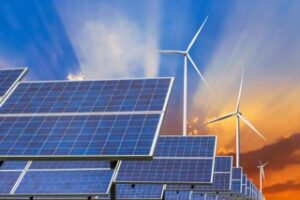By Heather Barden

The Department of Energy, in consultation with other key stakeholders, has developed a Virginia Energy Plan every four years since 2014 as prescribed by state law.[1] In 2021, the General Assembly amended the requirements for the Virginia Energy Plan in order to ensure future plans are in compliance with current statutory law.[2] The law currently states that the Virginia Energy Plan must identify actions over a 10 year period that are consistent with the goal of the state’s clean energy policy.[3] In accordance with this law, Governor Youngkin’s administration created the 2022 Virginia Energy Plan (“Plan”) and presented the Plan to the general public on October 3, 2022.[4]
Governor Youngkin’s Plan is organized by five guiding principles: reliability, affordability, innovation, competition, and environmental stewardship.[5] The Plan assesses data on the current state of Virginia’s energy needs and its projected needs, and provides recommendations to policymakers on how to ensure such energy needs are met.[6] Recommendations provided in the Plan include (but are not limited to): building a new small nuclear reactor plant in Southwest Virginia, scaling back or outright eliminating the state’s mandatory renewable portfolio standard requirements, investing in carbon capture technology, eliminating Virginia’s participation in RGGI, and creating new laws and/or regulations that address the higher energy costs being seen throughout the state.[7]
These actions would require state lawmakers to repeal or amend significant portions of the Virginia Clean Economy Act (“VCEA”).[8] In 2020, Virginia lawmakers amended and repealed parts of the state’s energy policy by passing the VCEA.[9] The VCEA drastically shifted the focus of the state’s energy policies towards addressing and combating climate change. Today, state law provides that the 2022 Virginia Energy Plan must identify actions over a 10-year period that are consistent with the goals of the Commonwealth’s current clean energy policy.[10] The Plan acknowledges this requirement and discusses, in some detail, the VCEA.[11]
Youngkin’s Plan heavily criticizes provisions of the VCEA and explains that Virginia is the only state amongst its competitors to have “inflexible implementation standards” for renewable energy.[12] The Plan argues that the “inflexible implementation standards” created by the VCEA, coupled with many other requirements laid out in the VCEA, are unsustainable and will lead to exorbitant energy costs over the next 30 years.[13]
Overall, the Plan implicitly and explicitly rejects the VCEA and in doing so, is not in compliance with Va. Code Ann. § 45.2-1706.1. The Plan touts an “all of the above” approach to make energy affordable to Virginians in the years to come.[14] However, this “all of the above” approach to lowering energy costs does not include recommendations that are in compliance with the goals of the state’s current clean energy policies. Simply put, the Plan does not forward the goals laid out in the VCEA. Because many of the policy recommendations laid out in the Plan are incongruent with the VCEA, policy makers will have no choice but to either amend or repeal most of the VCEA prior to implementing the Plan’s policies or reject the Plan’s recommendations outright.
[1] Va. Code Ann. § 45.2-1711(C) (amended 2021).
[2] Id.
[3] Va. Code Ann. § 45.2-1710(A) (amended 2021).
[4] Dep’t of Energy, 2022 Va. Energy Plan, Oct. 3, 2022.
[5] Id. at 10.
[6] Id. at 2-10.
[7] Id. at 16,19, 22.
[8] See Va. Code Ann. § 45.2-1706.1 (amended in 2021).
[9] Va. Code Ann. § 45.2-1706.1 (amended in 2021).
[10] Va. Code Ann. § 45.2-1711(C) (amended 2021).
[11] Dep’t of Energy, 2022 Va. Energy Plan 6, Oct. 3, 2022.
[12] Id.
[13] Id. at 7. The Plan states that “[f]ull compliance with the VCEA will increase electricity costs over 2020 levels by 53% by 2030 and 72% by 2035.”
[14] Id. at 10.

